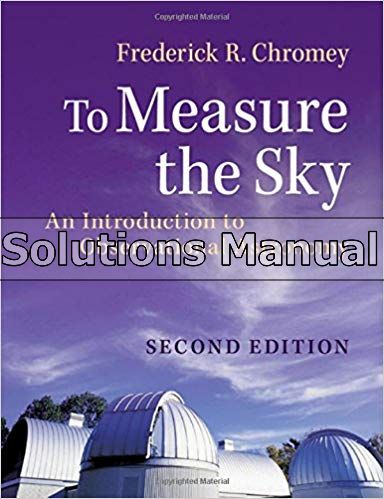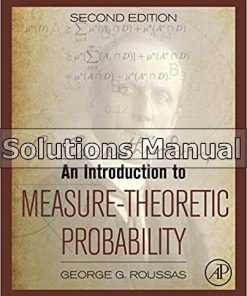Measure the Sky 2nd Edition Chromey Solutions Manual
You may also like
Measure the Sky 2nd Edition Chromey Solutions Manual

Product details:
- ISBN-10 : 9781107572560
- ISBN-13 : 978-1107572560
- Author:
The second edition of this popular text provides undergraduates with a quantitative yet accessible introduction to the physical principles underlying the collection and analysis of observational data in contemporary optical and infrared astronomy. The text clearly links recent developments in ground- and space-based telescopes, observatory and instrument design, adaptive optics, and detector technologies to the more modest telescopes and detectors that students may use themselves. Beginning with reviews of the most relevant physical concepts and an introduction to elementary statistics, students are given the firm theoretical foundation they need. New topics, including an expanded treatment of spectroscopy, Gaia, the Large Synoptic Survey Telescope, and photometry at large redshifts bring the text up to date. Historical development of topics and quotations emphasize that astronomy is both a scientific and a human endeavour, while extensive end-of-chapter exercises facilitate the students’ practical learning experience.
Table contents:
- Chapter 1 Light
- 1.1 The story
- 1.2 Models for the behavior of light
- 1.2.1 Electromagnetic waves
- 1.2.2 Quantum mechanics and light
- 1.2.3 A geometric approximation: light rays
- 1.3 Measurements of light rays
- 1.3.1 Luminosity and brightness
- 1.3.2 The inverse square law of brightness
- 1.3.3 Surface brightness
- 1.4 Spectra
- 1.4.1 Monochromatic flux
- 1.4.2 Flux within a band
- 1.4.3 Spectrum analysis
- The Fraunhofer spectrum
- The Kirchhoff–Bunsen results
- Blackbody spectra
- 1.4.4 Spectra of stars
- 1.5 Magnitudes
- 1.5.1 Apparent magnitudes
- 1.5.2 Absolute magnitudes
- 1.5.3 The bolometric correction
- 1.5.4 Apparent magnitudes from images
- 1.5.5 Example problem
- Exercises
- Chapter 2 Uncertainty
- 2.1 Accuracy and precision
- 2.1.1 An example
- 2.1.2 Accuracy and systematic error
- 2.1.3 Precision and random error
- 2.1.4 Uncertainty
- 2.1.5 Digitizing effects
- 2.1.6 Significant digits
- 2.2 Describing populations
- 2.2.1 Descriptive statistics of a finite population
- Measures of the central value
- Measures of dispersion
- 2.2.2 Estimating population statistics
- 2.3 Probability distributions
- 2.3.1 The random variable
- 2.3.2 The Poisson distribution
- 2.3.3 The Gaussian, or normal, distribution
- 2.3.4 The standard normal distribution
- 2.3.5 Other distributions
- 2.4 Estimating uncertainty
- 2.4.1 The central limit theorem
- 2.4.2 Reducing uncertainty
- 2.5 Propagation of uncertainty
- 2.5.1 Combining several variables
- 2.5.2 General rule
- 2.5.3 Several measurements of a single variable
- 2.6 Additional topics
- Exercises
- Chapter 3 Place, time, and motion
- 3.1 Astronomical coordinate systems
- 3.1.1 Three-dimensional coordinates
- 3.1.2 Coordinates on a spherical surface
- 3.1.3 Terrestrial latitude and longitude
- 3.1.4 The altitude–azimuth system
- 3.1.5 The equatorial system: definition of coordinates
- 3.1.6 The relation between the equatorial and the horizon systems
- 3.1.7 Measuring equatorial coordinates
- 3.1.8 Precession and nutation
- 3.1.9 Barycentric coordinates
- 3.1.10 The ICRS
- 3.1.11 The ecliptic coordinate system
- 3.1.12 The Galactic coordinate system
- 3.1.13 Transformation of coordinates
- 3.2 The third dimension
- 3.2.1 The astronomical unit
- 3.2.2 Stellar parallax
- 3.3 Time
- 3.3.1 Atomic time
- 3.3.1 Solar time
- 3.4 Motion
- 3.4.1 Space motion
- 3.4.2 Proper motion
- 3.4.3 Radial velocity
- Precise radial velocities
- Large redshifts
- Exercises
- Chapter 4 Names, catalogs, and databases
- 4.1 Star names
- 4.1.1 Proper names
- 4.1.2 Bayer designations
- 4.1.3 Flamsteed designations
- 4.1.4 Double stars, exoplanets, and variables
- 4.1.5 Durchmusterung numbers
- 4.1.6 The nomenclature problem
- 4.1.7 Other stellar catalogs
- 4.2 Non-stellar objects outside the Solar System
- 4.2.1 Bright objects
- 4.2.2 Faint non-stellar objects
- 4.3 Objects at non-optical wavelengths
- 4.4 Atlases, finding charts, and sky surveys
- 4.5 Solar System objects
- 4.6 Websites and other computer resources
- Exercises
- Chapter 5 Optics for astronomy
- 5.1 Principles of geometrical optics
- 5.1.1 Rays and wavefronts in dielectric media
- 5.1.3 Reflection and transmission coefficients
- 5.1.4 Reflecting materials
- 5.1.5 Transmitting materials
- 5.1.6 Thin film coatings
- 5.1.7 Cleaning
- 5.1.8 Reflection at a spherical surface
- 5.1.9 Refraction at a spherical surface
- 5.2 Lenses, mirrors, and simple optical configurations
- 5.2.1 Thick lenses
- 5.2.2 Thin lenses
- 5.2.3 Graphical ray tracing
- 5.2.4 Multiple lenses
- 5.2.5 The thick plane-parallel plate
- 5.2.6 Refraction by an atmosphere
- 5.2.7 Optical fibers
- 5.2.8 Prisms
- 5.3 Simple telescopes
- 5.3.1 Telescopes as single-element cameras
- 5.3.2 Image scale and image size
- 5.3.3 Focal ratio and image brightness
- 5.3.4 Telescopes with oculars
- 5.4 Image quality: telescopic resolution
- 5.4.1. The diffraction limit
- 5.4.2 Rayleigh refused: atmospheric seeing and optical aberrations
- 5.5 Aberrations
- 5.5.1 Chromatic aberration
- 5.5.2 Classification of monochromatic wavefront aberrations
- 5.5.3 Shapes of optical surfaces
- 5.5.4 Spherical aberration
- 5.5.5 Coma
- 5.5.6 Astigmatism
- 5.5.7 Field curvature
- 5.5.8 Distortion
- 5.5.9 Other aberrations and ray tracing in practice
- Exercises
- Chapter 6 Astronomical telescopes
- 6.1 Telescope mounts and drives
- 6.1.1 Altazimuth and equatorial mounts
- 6.1.2 Telescope mounts in space
- 6.2 Reflecting telescope optics
- 6.2.1 Prime focus and Newtonian focus
- 6.2.2 Cassegrain and Gregorian reflectors
- 6.2.3 Aplanatic two-mirror telescopes
- 6.2.4 Nasmyth and coudé foci
- 6.2.5 Three-mirror telescopes
- 6.2.6 Schmidt telescopes
- 6.2.7 Other catadioptric telescopes
- 6.3 Telescopes in space
- 6.3.1 Advantages of space telescopes
- Resolution
- Detection limits
- Background
- Atmospheric transmission
- Access to sky
- Perturbing forces and environment
- 6.3.2 Disadvantages of space telescopes
- 6.3.3 Airborne telescopes
- 6.3.4 The James Webb Space Telescope
- 6.4 The current revolution in ground-based observing
- 6.4.1 Large mirrors
- 6.4.2 Observatory engineering
- 6.4.3 Computers
- 6.5 Atmospheric blur
- 6.5.1 Atmospheric wavefront (WF) distortion
- 6.5.2 High resolution on short exposures
- 6.5.3 Quantifying wavefront distortion
- 6.6 Adaptive optics
- 6.6.1 The idea of adaptive optics
- 6.6.2 The Greenwood time delay
- 6.6.3 Anisoplanatism
- 6.6.4 Guide stars
- 6.6.5 Wavefront correctors
- 6.6.6 Wavefront sensors
- 6.6.7 A simple AO system
- 6.6.8 Advanced AO systems
- 6.7 Extremely large telescopes
- Exercises
- Chapter 7 Matter and light
- 7.1 Isolated atoms
- 7.1.1 Atomic energy levels
- 7.1.2 Absorption of light by atoms
- 7.1.3 Emission of light by atoms
- 7.1.4 Collisions and thermal excitation
- 7.1.5 Specification of energy levels
- 7.2 Isolated molecules
- 7.3 Solid-state crystals
- 7.3.1 Bonds and bands in silicon
- 7.3.2 Conductors, semiconductors, and insulators
- 7.3.3 Intrinsic semiconductors
- Semiconductor crystals
- Conductivity and temperature
- 7.3.4 Intrinsic photo-absorbers
- 7.3.5 Extrinsic semiconductors
- 7.4 Photoconductors
- 7.4.1 Simple photoconductors
- 7.4.2 The blocked impurity band photoconductor
- 7.5 The MOS capacitor
- 7.6 The p–n junction
- 7.6.1 Generation and recombination
- 7.6.2 p–n junction diodes
- 7.6.3 Light detection in diodes
- 7.6.4 Variations on the junction diode
- 7.7 The vacuum photoelectric effect
- 7.8 Superconductivity
- 7.8.1 The superconductor band gap
- 7.8.2 Light detection in an SIS junction
- 7.8.3 Light detection in kinetic induction devices
- Exercises
- Chapter 8 Detectors
- 8.1 Detector characterization
- 8.1.1 Detection modes
- 8.1.2 Efficiency and yield
- 8.1.3 Noise
- 8.1.4 Spectral response and discrimination
- 8.1.5 Linearity and dynamic range
- 8.1.6 Stability
- 8.1.7 Response time
- 8.1.8 Physical size and pixel count
- 8.1.9 Image sampling and degradation
- 8.2 The CCD
- 8.2.1 General operation
- 8.2.2 Channel stops, blooming, full well, and gain
- 8.2.3 Readout time, read noise, and bias
- 8.2.4 Dark current, cooling, and vacuum enclosures
- 8.2.5 Charge transfer efficiency
- 8.2.6 The buried channel CCD
- 8.2.7 The MPP CCD
- 8.2.8 CCD variations
- 8.2.9 CCD sensitivity issues
- Frontside options
- Backthinning
- Anti-reflection coatings
- 8.2.10 Drift scanning and time delayed integration
- 8.3 CMOS arrays
- 8.4 Infrared arrays
- 8.4.1 Detectors at different wavelengths
- Silicon IR and SWIR (0.72–1.1 and 0.9–2.5 μm)
- Thermal infrared
- 8.4.2 Infrared detector construction
- 8.5 Photo-emissive devices
- 8.5.1 The photomultiplier tube
- 8.5.2 The microchannel plate
- 8.5.3 Image intensifiers and the ICCD
- 8.6 Thermal detectors
- Exercises
- Chapter 9 Digital images from arrays
- 9.1 Arrays
- 9.1.1 Pixels and pixel response
- 9.1.2 Digital images
- 9.1.3 CCD gain
- 9.1.4 Pictures lie
- 9.2 Digital image manipulation
- 9.2.1 Basic image arithmetic
- 9.2.2 Image dimensions and color
- 9.2.3 Image functions
- 9.2.4 Image convolution and filtering
- 9.3 Preprocessing array data: bias, linearity, dark, flat, and fringe
- 9.3.1 Bias frames
- 9.3.2 Overscan and reference pixels
- 9.3.3 Dark current
- 9.3.4 Detector linearity
- 9.3.5 Flat field
- Twilight flats
- Dark-sky flats
- Dome flats
- Space telescope flats
- Computing simple flats
- Compound flats
- 9.3.6 Preprocessing data frames
- 9.3.7 Fringing
- 9.4 Combining images
- 9.4.1 Where is it? The centroid
- 9.4.2 Where is it, again? PSF fitting
- 9.4.3 Aligning images: shift, canvas, and trim
- 9.4.4 Aligning images: geometric transformations
- 9.4.5 Interpolation
- 9.4.6 Resampling, interlace, and drizzle
- 9.4.7 Cleaning images
- 9.5 Digital aperture photometry
- 9.5.1 Digital apertures and PSF fits
- 9.5.2 Measuring the sky
- 9.5.3 Signal and noise in an aperture
- 9.5.4 The CCD equation
- Exercises
- Chapter 10 Photometry
- 10.1 Introduction: a short history
- 10.2 The photometric response function
- 10.2.1 Types of photometry
- Single-band photometry
- Broadband multicolor photometry
- Narrow- and intermediate-band photometry
- 10.2.2 Magnitudes
- 10.2.3 Response function implementation
- 10.2.4 Response function description
- 10.2.5 Color indices
- 10.2.6 Line and feature indices
- 10.3 The idea of a photometric system
- 10.4 Common photometric systems
- 10.4.1 Visual and photographic systems
- 10.4.2 The UBVRI system
- 10.4.3 The SDSS ugriz(y) system
- 10.4.4 The broadband infrared systems: ZYJHKLMNQ
- 10.4.5 The intermediate-band Strömgren system: uvbyβ
- 10.4.6 Other systems
- 10.5 Absorption by the atmosphere
- 10.5.1 Atmospheric windows
- 10.5.2 Absorption by a plane-parallel slab
- 10.5.3 Bouguer’s law
- 10.5.4 Sources of extinction
- Rayleigh scattering by molecules
- Absorption by ozone
- Scattering by aerosols
- Molecular-band absorption
- 10.5.5 Heterochromatic extinction
- 10.5.6 Compensating for extinction: theory
- 10.5.7 Compensating for extinction: practice
- Case 1: assume a mean extinction
- Case 2: use known outside-the-atmosphere magnitudes
- Case 3: draw the Bouguer line from observations
- Case 4: variable extinction
- Case 5: use all the data
- 10.5.8 Indices or magnitudes?
- 10.6 Transformation to a standard system
- 10.7 Absorption outside the atmosphere
- 10.7.1 The interstellar medium
- 10.7.2 Interstellar absorption and reddening
- 10.7.3 The interstellar reddening law
- 10.7.4 Spectroscopic parallax
- 10.8 Wavelength changes
- 10.8.1 Redshift and photometry
- 10.8.2 The K correction
- 10.8.3 Absorption outside our Galaxy
- Exercises
- Chapter 11 Spectroscopy
- 11.1 Dispersive spectrometry
- 11.2 Dispersing optical elements
- 11.2.1 Prisms
- 11.2.2 The diffraction grating
- 11.2.3 Blazed gratings
- 11.2.4 Echelles
- 11.2.5 Volumetric phase gratings
- 11.2.6 Grating manufacture
- 11.3 Spectrometers without slits
- 11.3.1 The objective prism
- 11.3.2 The non-objective prism and grism
- 11.4 Basic slit and fiber spectrometers
- 11.5 Single-object spectrometer design for astronomy
- 11.5.1 An example configuration
- 11.5.2 Slit orientation and spectrum widening
- 11.5.3 Getting light in
- 11.6 Multiplexed spectrometers
- 11.6.1 Spectra without dispersion – energy-resolving detectors
- 11.6.2 Long-slit spectrometers
- 11.6.3 Integral field spectrometers
- Image slicers
- Fiber mosaics
- Lenslet arrays
- 11.6.4 Multi-object spectrometers
- 11.6.5 Refinements
- 11.7 Spectrometer stability and mounting
- 11.8 Data acquisition and reduction
- 11.8.1 Observing practices
- 11.8.2 Spectrum extraction
- 11.8.3 Wavelength calibration
- 11.8.4 Flux calibration
- 11.8.5 Other calibrations
- 11.9 Interpreting spectra
- 11.9.1 Classification of stellar spectra
- 11.9.2 Spectra of gaseous nebulae
- 11.9.3 Measuring line strength
- 11.9.4 Line profiles
- Natural broadening
- Instrumental broadening
- Rotational broadening
- Thermal broadening
- Microturbulence
- Pressure broadening
- Abundances
- 11.9.5 The redshift parameter
- 11.9.6 Determination of masses
- 11.9.7 Exoplanets
- 11.9.8 Galaxies and the universe
- The Hubble law
- Determining the value of H0
- High z supernovae and dark energy
- Exercises
- Appendices
- Appendix A General reference data
- A1 The Greek alphabet
- A2 Metric system prefixes and symbols
- A3 Physical constants
- A4 Astronomical constants
- A5 Conversions
- Appendix B Light
- B1 Photon properties
- B2 The strongest Fraunhofer lines
- B3 Sensitivity of human vision
- B4 The visually brightest stars
- Appendix C
- C1 The standard normal distribution
- Appendix D
- D1 The nearest stars
- D2 The equation of time
- D3 Coordinate transformations and relations
- D4 Atmospheric refraction
- D5 Astrometric catalogs
- D6 Days and years
- Appendix E
- E1 The constellations
- E2 Some named stars
- E3 Naming small bodies in the Solar System
- Minor planets
- Comets
- Natural satellites of the major and minor planets
- Appendix F
- F1 A timeline for optical telescopes
- Appendix G
- G1 Websites
- G2 Largest optical telescopes (2015)*
- G3 Large Schmidt telescopes
- Appendix H
- H1 The hydrogen atom
- H2 Some common semiconductors
- Appendix I
- I1 Characteristics of some commercial CCDs for astronomy
- I2 Manufacturers of sensors and cameras for astronomy
- Appendix J
- J1 The point-spread function
- Appendix K
- K1 Intrinsic broadband colors for various spectral types
- References
- Index
People also search:
to measure the sky 2nd edition pdf
to measure the sky 2nd edition
how to measure the sky
how is a second measured
how do we measure a second












